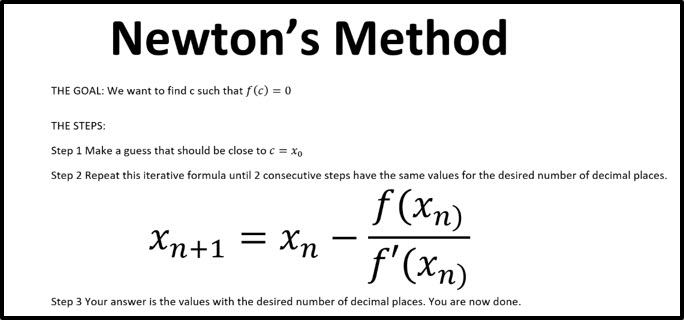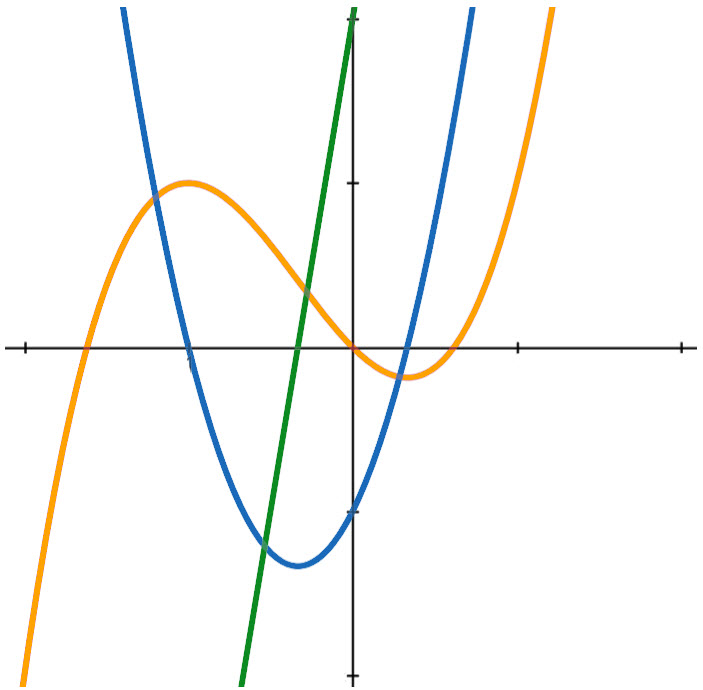Andymath.com features free videos, notes, and practice problems with answers! Printable pages make math easy. Are you ready to be a mathmagician?
Notes

Questions
For #1-4, use Newton’s method to find \(x_1\) and \(x_2\) for the given initial guess
\(\textbf{1)}\) \(f(x)=x^3-4, \, x_0=1.8\)
\(\textbf{2)}\) \(f(x)=\sin x, \, x_0=1.8\)
\(\textbf{3)}\) \(f(x)=5-x^2, \, x_0=1.8\)
\(\textbf{4)}\) \(f(x)=x^2-4, \, x_0=10\)
\(\textbf{5)}\) Using Newton’s method, find the root in the given range accurate to 4 decimal points \(f(x)=x^4-3x^2+4x-6, \, [1,3]\)
\(\textbf{6)}\) Using Newton’s method, find all the roots accurate to 4 decimal points \(f(x)=x^2-5\)
\(\textbf{7)}\) Find \(\sqrt[5]{58}\) to 4 decimal points using Newton’s method
See Related Pages\(\)
\(\bullet\text{ Calculus Homepage}\)
\(\,\,\,\,\,\,\,\,\text{All the Best Topics…}\)
\(\bullet\text{ Definition of Derivative}\)
\(\,\,\,\,\,\,\,\, \displaystyle \lim_{\Delta x\to 0} \frac{f(x+ \Delta x)-f(x)}{\Delta x} \)
\(\bullet\text{ Equation of the Tangent Line}\)
\(\,\,\,\,\,\,\,\,f(x)=x^3+3x^2−x \text{ at the point } (2,18)\)
\(\bullet\text{ Derivatives- Constant Rule}\)
\(\,\,\,\,\,\,\,\,\displaystyle\frac{d}{dx}(c)=0\)
\(\bullet\text{ Derivatives- Power Rule}\)
\(\,\,\,\,\,\,\,\,\displaystyle\frac{d}{dx}(x^n)=nx^{n-1}\)
\(\bullet\text{ Derivatives- Constant Multiple Rule}\)
\(\,\,\,\,\,\,\,\,\displaystyle\frac{d}{dx}(cf(x))=cf'(x)\)
\(\bullet\text{ Derivatives- Sum and Difference Rules}\)
\(\,\,\,\,\,\,\,\,\displaystyle\frac{d}{dx}[f(x) \pm g(x)]=f'(x) \pm g'(x)\)
\(\bullet\text{ Derivatives- Sin and Cos}\)
\(\,\,\,\,\,\,\,\,\displaystyle\frac{d}{dx}sin(x)=cos(x)\)
\(\bullet\text{ Derivatives- Product Rule}\)
\(\,\,\,\,\,\,\,\,\displaystyle\frac{d}{dx}[f(x) \cdot g(x)]=f(x) \cdot g'(x)+f'(x) \cdot g(x)\)
\(\bullet\text{ Derivatives- Quotient Rule}\)
\(\,\,\,\,\,\,\,\,\displaystyle\frac{d}{dx}\left[\displaystyle\frac{f(x)}{g(x)}\right]=\displaystyle\frac{g(x) \cdot f'(x)-f(x) \cdot g'(x)}{[g(x)]^2}\)
\(\bullet\text{ Derivatives- Chain Rule}\)
\(\,\,\,\,\,\,\,\,\displaystyle\frac{d}{dx}[f(g(x))]= f'(g(x)) \cdot g'(x)\)
\(\bullet\text{ Derivatives- ln(x)}\)
\(\,\,\,\,\,\,\,\,\displaystyle\frac{d}{dx}[ln(x)]= \displaystyle \frac{1}{x}\)
\(\bullet\text{ Implicit Differentiation}\)
\(\,\,\,\,\,\,\,\,\)
\(\bullet\text{ Horizontal Tangent Line}\)
\(\,\,\,\,\,\,\,\,\)
\(\bullet\text{ Mean Value Theorem}\)
\(\,\,\,\,\,\,\,\,\)
\(\bullet\text{ Related Rates}\)
\(\,\,\,\,\,\,\,\,\)
\(\bullet\text{ Increasing and Decreasing Intervals}\)
\(\,\,\,\,\,\,\,\,\)
\(\bullet\text{ Intervals of concave up and down}\)
\(\,\,\,\,\,\,\,\,\)
\(\bullet\text{ Inflection Points}\)
\(\,\,\,\,\,\,\,\,\)
\(\bullet\text{ Graph of f(x), f'(x) and f”(x)}\)
\(\,\,\,\,\,\,\,\,\)
\(\bullet\text{ Newton’s Method}\)
\(\,\,\,\,\,\,\,\,x_{n+1}=x_n – \displaystyle \frac{f(x_n)}{f'(x_n)}\)
In Summary
Newton’s method involves starting with an initial guess for the root of a function, and then using that guess to approximate the root using a linear approximation of the function. The process is then repeated using the updated estimate until the root is found to within a certain tolerance.
Why do we learn about Newton’s method? Newton’s method is a powerful tool for finding roots of functions, and is particularly useful for nonlinear functions where other methods may not work as well. It is also relatively fast and easy to implement, making it a popular choice in many areas of science and engineering.
What math class is Newton’s method in? Newton’s method is typically covered in advanced calculus or numerical analysis courses, as it involves concepts such as differentiation and convergence.
What are common mistakes with Newton’s method? One common mistake when using Newton’s method is failing to choose a good initial guess for the root. It is also important to ensure that the function is well-behaved and that the linear approximation used in the method is accurate.
Who discovered Newton’s method? Newton’s method is named after Isaac Newton, who is credited with its discovery in the late 17th century. However, it was later generalized and refined by Joseph Raphson in the early 18th century.
What are some related topics to Newton’s method? Some related topics to Newton’s method include root-finding algorithms, optimization techniques, and numerical analysis. It is also closely related to concepts such as differentiation and convergence in calculus.
Topics that use Newton’s method
Root-finding: Newton’s method is a popular algorithm for finding the roots of a function, which are the values of the input that make the function equal to zero.
Optimization: Newton’s method can also be used to find the local minima or maxima of a function by searching for the roots of its derivative.
Machine learning: Newton’s method is used in some machine learning algorithms, such as logistic regression, to find the optimal values of the model parameters that minimize the loss function.
Data fitting: Newton’s method can be used to fit a curve to a set of data points by minimizing the sum of the squared errors between the curve and the data.
Nonlinear equations: Newton’s method can be used to solve systems of nonlinear equations by iteratively improving an initial guess for the solution until convergence is reached.
About Andymath.com
Andymath.com is a free math website with the mission of helping students, teachers and tutors find helpful notes, useful sample problems with answers including step by step solutions, and other related materials to supplement classroom learning. If you have any requests for additional content, please contact Andy at tutoring@andymath.com. He will promptly add the content.
Topics cover Elementary Math, Middle School, Algebra, Geometry, Algebra 2/Pre-calculus/Trig, Calculus and Probability/Statistics. In the future, I hope to add Physics and Linear Algebra content.
Visit me on Youtube, Tiktok, Instagram and Facebook. Andymath content has a unique approach to presenting mathematics. The clear explanations, strong visuals mixed with dry humor regularly get millions of views. We are open to collaborations of all types, please contact Andy at tutoring@andymath.com for all enquiries. To offer financial support, visit my Patreon page. Let’s help students understand the math way of thinking!
Thank you for visiting. How exciting!